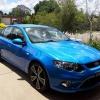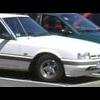-
Forum Statistics
7,836
Total Topics261,994
Total Posts -
Member Statistics
-
Who's Online 2 Members, 0 Anonymous, 437 Guests (See full list)
-
Topics
-
Posts
-
I have a complete running crossflow from a Bronco, if you are interested.
-
If the dizzy I have comes back not usable I'll either pick up a DSM dizzy or a pertronix module. I'm planning on running a CDI box with the electric dizzy, I was thinking of just biting the bullet and getting a MSD Ultra 6AL plus so I'll have a boost controller avalible for use when I need it.
-
make a wanted post, but generally either finding wreckers engines or facebook is usually the easiest way.
the forums are pretty slow for ads generally. especially for something as heavy as a crank to pack and send safely.
some engine reconditioners might have spare cranks sitting on shelves for 20yrs if they'd been around for long enough. -
By Harrison Kotrolos · Posted
My bad, it is indeed a 250 crossflow.
Got a few more engines I'm hunting down, but may need to take the approach on redoing a whole new block to suit the cranks I have.
Unless someone on the forums has a earlier, flange crankshaft for a 250 crossflow lying around -
yeah cool, people that make fast crossflows ditch the XE type for the EFI/EA onwards type, more stable at higher revs and used with an MSD box or similar.
i didn't expect there'd be a direct fit, but that's a fair effort that gets it done still (the pertronix kit is simple, fairly cheap, and could go back to points very easily if needed) -
i believe the later ones (same size journals as EF 4.0 etc ) are smaller, so not usable. assuming you mean a 250 crossflow, i can't remember ever person's project off the top of My head.
-
Form the fordsix forum "You need a sacrificial dizzy XY-XB. Keep the '68 unit whole as a startup/spare one. I always say to start a new motor with a points unit, as it's 100% guaranteed to fire.
The shaft from the sacrificial dizzy is TIG'ed to the advance plate of the XE unit, which is rebushed or reamed to fit the upsize. Main reason for doing this way is it's rebushing at the same time, so wear's eliminated. The hold-down collar is turned to match the '68 unit - thinner and smaller. Use an appropriate driven gear against the cam.
That and bypassing the resistive wire, are pretty much the main details to your install. It's often a mongrel to get the hold-down clamp bolt threaded in while simultaneously dropping the unit home, but once you have a feel for it - no problem. Having a helper to rock the balancer pulley slightly, can assist.
If you pull the dizzy right down, you need to make a tool for reinstalling the clip inside the rotor shaft bore. It's a hollow mandrel - nothing fancy.
If the electronic dizzy is in reasonable condition (not needing a rebush), you might be able to just make a thick sleeve for the shaft end - depends on your skill and facilities at work.
Actual recurving gets to be fun. It's beyond the scope of what I feel comfortable with. You need to run enough advance to max your possible torque peak (200 RPM below your shift point, typically) but not come in fully, too soon before. Add to that the need for negligible mech advance off-idle and you have two end-points... The bit in the middle is territory for either a dyno or skilled hand.
I'll try to get pictures of the spare 221-converted dizzy I've got here. Waiting to build an engine around it." this seems to outline what needs to be done to make a later dizzy fit a pre xflow. not sure if it'd be worth the effort lol. -
By Harrison Kotrolos · Posted
Nothing rare. Am trying to source another crank for my engine as the snub on it got bent.
The block is an earlier one with the two-piece rear seal and flange on the crank, which I'm finding hard to replace, I have 3 newer cranks with the small and large rear main seal.
Can I use later cranks in the earlier block? (I.e the single rear seal in a two piece seal block?) -
is it some rare crank?
it's probably going to cost more than finding another, but there's ways things like that can usually be fixed to My understanding but the time/$$ would add up faster than the cost of another crank.







